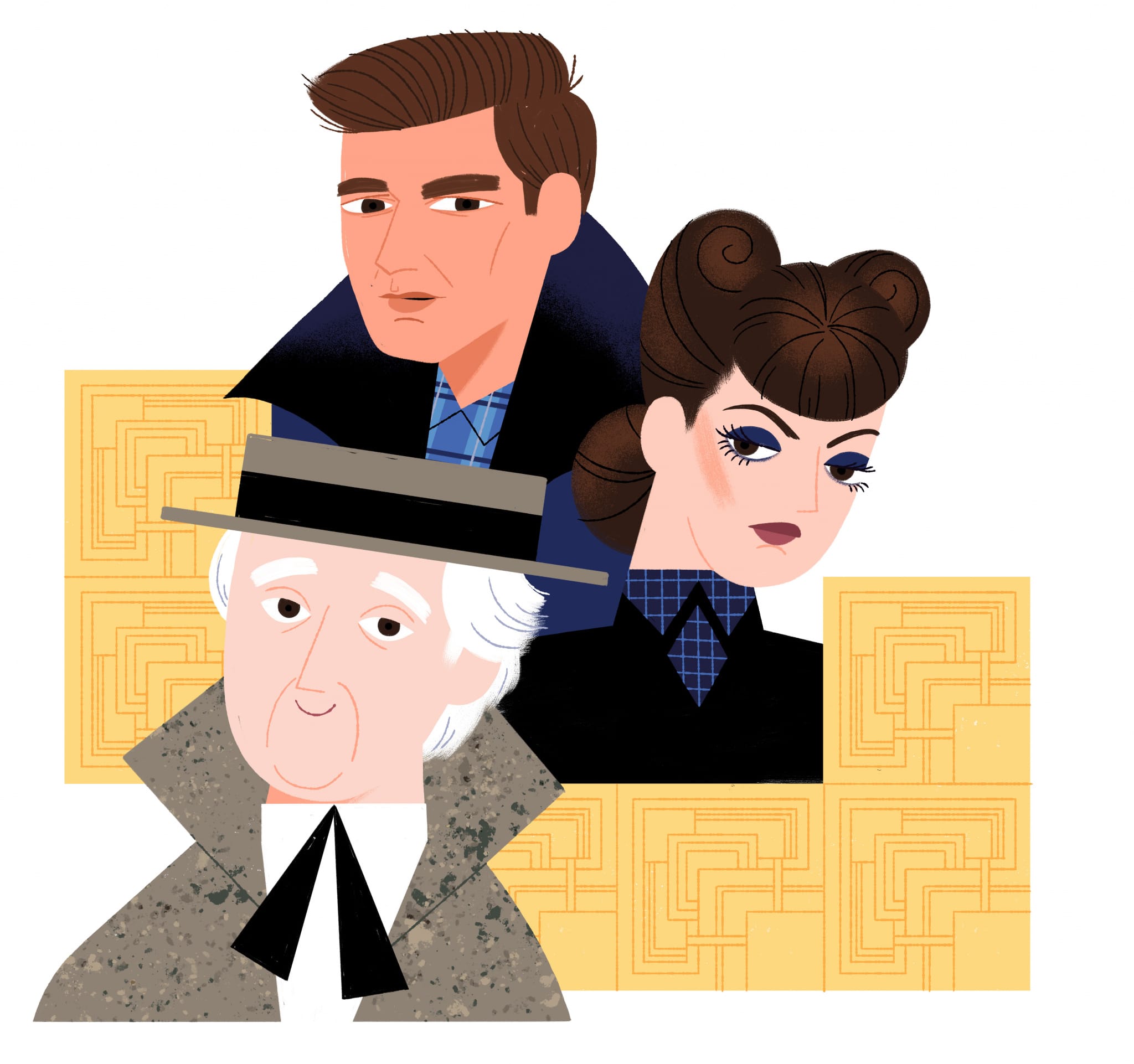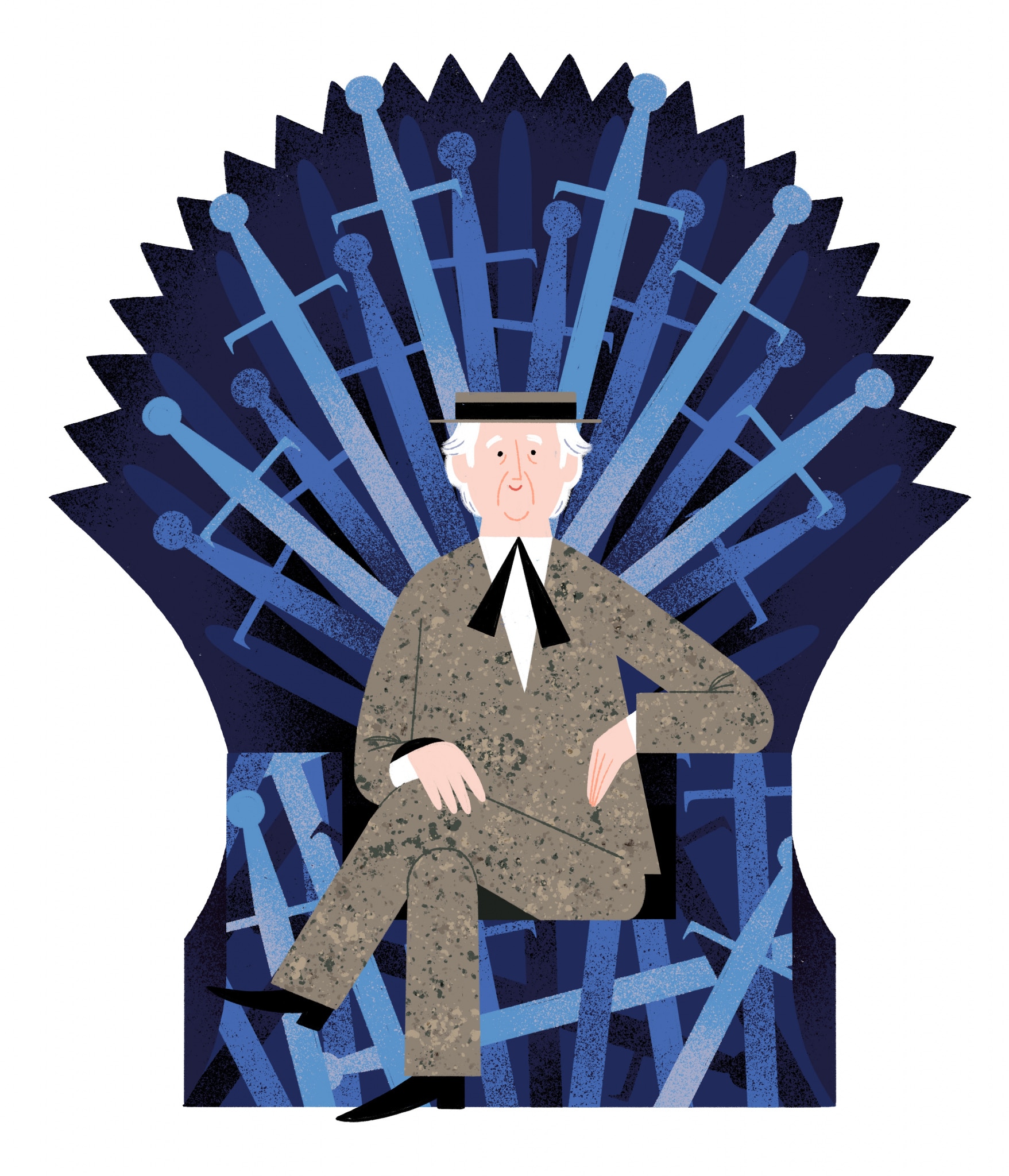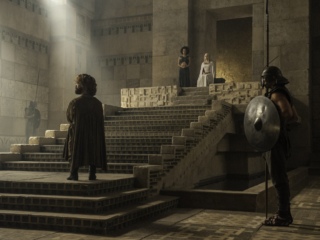
A Step Ahead: Frank Lloyd Wright’s Infinite Relevance
Darran Anderson with Illustrations by Ellen Surrey | Jan 24, 2020
Decades after Frank Lloyd Wright’s passing, his enduring influence and connection to some of the biggest popular culture phenomena today is clear. Author Darran Anderson delves into this influence, and shares how we can continue to learn from him in the 21st century and beyond.
“Everything changes and nothing stands still,” the Greek philosopher Heraclitus of Ephesus observed. It was a quote Frank Lloyd Wright repeated many times during his life, albeit in an altered form, “There is nothing permanent except change.” It would suggest that the passage of time makes vibrant things redundant, shuffling once-significant people off into obscurity, and that all achievement is hubristic. It is curious then that Wright remains such a dynamic presence today; someone who has inspired everything from science fiction films to comic books, fashion to video games, as well as countless designers and architects. How does a figure born in 1867 perpetually feel ahead of us in time?
One reason for Wright’s continuing prescience was his openness to the world; particularly in his interest in, and adaptations of, vernacular architecture. He had learned from his mentor, Louis Sullivan, of the importance of creating buildings that rose to the challenges of modernity, but did not lose a sense of beauty and personal connection. While interesting and charming, it’s evident, however, in Wright’s early work that he was struggling to find a singular voice. The weight of earlier styles, such as mock-Tudor, Queen Anne, and Shingle, stifled as much as it inspired.

Frank Lloyd Wright’s Imperial Hotel was used as inspiration for the Brick Mansion in the film Isle of Dogs. Illustration by Ellen Surrey
Wright realized something more adventurous, pluralist, and able to chime with the surroundings was required. His breakthrough came, ironically, with his dismissal for taking work on the side, freeing, and forcing, him to find his own path.
In an embodiment of the Roman playwright Terence’s phrase “I am human and let nothing human be alien to me,” Wright took inspiration from a multitude of global architectural sources. His gaze spanned continents and centuries. There is an element of Orientalism and the risk of pastiche in such an approach, appropriating decorative elements without the meanings or cultural context. Yet there is a depth and consideration at work with Wright’s work, beyond the reduction into aesthetics, that delves into the very meaning and existence of space. The influence of Japan loomed large for Wright.
It was not just a case of borrowing pagoda rooftops for his Hills-DeCaro House but rather utilising profound ideas, for example, Taoism and Zen in the harmonised landscape and architecture of Fallingwater.
From traditional Japanese architecture, Wright learned the importance of minimalism and framing, the possibility of buildings that would have a more permeable relationship between inside and out, the need to balance with the surroundings, and the radical importance of geometry as a way of unifying and diversifying space.
For all the undoubted debts that Wright owed Japanese architecture, this was not one-way traffic. He designed a number of profoundly influential buildings in Japan including the still-surviving Yodokō Guest House (many others, like the Shimpei Goto House and his Ginza Motion Picture Theatre, remained startling but unbuilt). Above them all loomed his Imperial Hotel, Tokyo, which had a colossal impact upon Japanese designers, especially after it survived the devastating Great Kantō earthquake of 1923 (it would sadly not survive developers in the 1960s). The building has had an intriguing afterlife as the source of the Brick Mansion in Wes Anderson’s Isle of Dogs; the base of the domineering mayor of Megasaki city. The grandeur of Wright’s hotel, the sense of it being a strident modern Japanese palace, is replicated but also amplified and distorted. Whereas Wright’s hotel worked sympathetically with its surroundings, built with warm and soft Ōya lava stone, and was self-contained in a contemplative way with its greenery and reflecting pool, Brick Mansion dominates the city skyline in bold and ominous tones of red and black. It is an ingenuous transformation that turns Wright’s place of solace and repose into a formidable centre of power.
On the other side of the Pacific, it’s fascinating to see how Wright’s uniquely American Prairie Style is full of Japanese touches; the horizontal lines and embedding in the environment for example, which is not a paradox given America’s ability, at its best, to absorb inputs and people from all over the world. This was a cultural exchange that vastly expanded the vocabulary and grammar of architecture in both countries.
Endlessly curious, Wright sought out other cultures and sought to learn the lessons they’d already learned. He did so not by simply replicating but by incorporating, reimagining and synthesising them into his work. Wright was a romantic at heart, grown up with his childhood fixation on “One Thousand and One Nights,” and while this posed the danger of slipping into fantastic follies, Wright always had the practical idea of how architecture could bring people and the environment together at his core.
Hence, we find the influence of the ziggurats of ancient Mesopotamia and echoes of the minaret of Great Mosque of Samarra (and indeed the Tower of Babel) in a series of Wright’s buildings, most famously in his Guggenheim museum, albeit inverted into an “optimistic ziggurat”, and his unbuilt Gordon Strong Automobile Objective. This occurred not because Wright wanted Disney-like set design, but because it offered alternative ways of moving around within space.

Wright’s Ennis House was used as the setting for Rick Deckard’s apartment in Blade Runner (1982). Illustration by Ellen Surrey
When commissioned to design the Annunciation Greek Orthodox Church, Wright turned to the glorious Hagia Sophia in Istanbul and created a Byzantine dome with a cross enveloped in a circle. There is certainly a thematic and storytelling element at work but one grounded in reality, functioning as a way for modernity to retain a connection to the past. As Wright put it, “The edifice is in itself a complete work of modern art and science belonging to today but dedicated to ancient tradition—contributing to Tradition instead of living upon it.” For the Beth Sholom Congregation and the Pilgrim Congregational Church, Wright created a Mount Sinai and a tent rising as architecture out of the desert, like a dream, mirage or memory but also fully-functional modern places of worship.

Wright’s textile block homes inspired scenic design in Game of Thrones. Illustration by Ellen Surrey
Why does this absorption of cultures and times make Frank Lloyd Wright futuristic? Well, because the future happens everywhere. In the mainstream conceptions of the future, the dominant superpowers of United States and the Soviet Union traditionally prevailed, alongside later technologically-advanced societies like Hong Kong, Japan, Dubai and so on. Yet the future will happen everywhere, and nowhere, no matter how dazzling, has a monopoly on it. It will take place from São Paulo to Reykjavik to Lagos to Djakarta, each will have universal qualities and unique local peculiarities.
By bringing vernacular architecture (recognising that every architecture is vernacular, but that some dominate over others) into modern and futuristic forms as Wright did, he provided a rich palette and a sense of believability for speculative fiction. In the case of “Star Wars,” the cultures of different planets seem to riff on and amalgamate different architectural traditions from the Renaissance to Moorish and beyond. The key lies in the fact that it is set, “A long time ago in a galaxy far, far away,” meaning there is a sense of history at work, a sense of deep time as well as deep space.
In the setting of Naboo, we find the direct influence of Wright’s Marin County Civic Center and the sense that influence ripples from the Byzantine-era through Wright to the interstellar worlds that George Lucas and co envisaged.
With “Blade Runner,” the anti-hero Deckard lives in a replica of Wright’s Maya Revival Ennis House. This was crucial to the director Ridley Scott’s attempts to create a fully-realized world and a “lived-in” future city. The future will be older than the present and so, using Wright’s example, Scott aimed for a sense of implied history. It is an approach that Wright himself made with his Storer House, appearing like a Maya temple overgrown with jungle.
Along with Wright’s Hollyhock House, Ennis House was used again as inspiration; this time in “Game of Thrones” as the art director and production designer Deborah Riley reveals: “When Meereen was first described to me, I was told it was a pyramid city and that its wealthiest residents lived inside the pyramids. Having visited Mexico City a number of years ago, I first started revisiting my photographs of Mayan pyramidal architecture and I suddenly recalled Frank Lloyd Wright and his Mayan Revival Period of the 1920s. As we had to work so quickly on Game of Thrones, at first it felt like cheating, but it gave me great comfort to think that he had already solved the problem of how to make the monolithic structures also feel domestic. Just as importantly, his work, to me, does not speak of a particular period, and it was possible for us to translate the spaces so that they felt simultaneously medieval and modern.”
The second reason Wright’s work appears futuristic is his enthusiasm for organic architecture, which was both way ahead of its time and a modernization of the Garden City concept. While others went on to create utopian Space Age visions and then its grimy cyberpunk hangover, Wright was unveiling plans, such as Broadacre City, that were arguably Solarpunk (a movement that has emerged in recent times in response to the challenges of climate change). Wright could see that the only way to humanize the built environment was to treat it as an environment. This would mean working in harmony with nature, seeing architecture as part of the landscape, incorporating waterfalls and rivers (Fallingwater), surrounding topography (Sea Cliff), islands and wetlands (Greater Baghdad, Ellis Island etc) and larger ideas of sustainability and conservation (the solar-friendly Herbert and Katherine Jacobs II House). The architect encouraged clients to build near rivers, ravines, uplands, creeks, woodland, bluffs, even clifftops. His buildings found their way into the ebb and flow of the landscape without obstruction. For Wright, as it is now for progressive architects, all architecture is landscape architecture. “No house should ever be on a hill or on anything.” He wrote in his autobiography, “It should be of the hill. Belonging to it. Hill and house should live together each the happier for the other.”
The future, if we are to have a future, must be green; a view that Wright shared long before it was accepted in the mainstream culture. This is evident not just in his approaches of using local materials and maintaining natural surroundings but in the very inspiration and meanings of his architecture. Often, at his strangest, there was an organic root to his ideas. The astonishingly modern columns of his Johnson Wax Headquarters were inspired by trees and lillypads. He regularly built dwellings according to shapes found in nature – the Honeycomb House, the Snowflake of the Carlton D. Wall House, and the tadpole-shaped Polliwog of the Tonkens House.
Wright’s mix of pioneering modern amenities and building technologies with the ecosystems of nature and ancient styles is at the root of the reinvention of his Millard House, or La Miniatura, in the television series “Westworld.” Here it re-emerges as the home of the co-founder of the android amusement park, Arnold Weber.
The mix of the old and new, the hyper-technological and the natural, seems paradoxical but Wright demonstrated long ago that these combinations were the future because we were all already living amidst these overlapping systems. The third element of Wright’s continuing relevance is his sense of beauty and idiosyncrasy. “Every great architect is—necessarily—a great poet,” he claimed, and it’s evident in the ornamentation of his textile and stained-glass designs, that graced many of his buildings. Like other modernists, Wright employed minimalism but his use was a way of concentrating attention elsewhere and maximising the impact of the decorative.
His rooms were rarely monastic in the more puritanical modernist sense but offered unique character, united by his geometric style but as individual to each place as the names he baptised his individual structures with (Toyhill, Romeo and Juliet Windmill, and so on).

Wright’s Millard House set the scene for Bernard’s house in HBO’s Westworld. Illustration by Ellen Surrey
With the arrival of augmented reality and 3-D printing, we may see a renaissance in this practice, and indeed already Wright’s quirks and sense of the poetic as it applies to each individual have been inspiring contemporary artists from fashion designers such as Opening Ceremony and Carmen Rivera, inspired by his democratic Usonian ideas, to William Chyr’s astonishing forthcoming Manifold Gardens video game, which expands like a fathomless puzzle box, partly inspired by a visit to Wright’s Robie House.
Wright’s work survives because of his vision and talent, but also because his work is unfinished. So much of his work is lost or remains unbuilt and thus tantalizing. It is his ethical vision however that makes him so vital: “All fine architectural values are human values, else not valuable,” he said, which is even more of a challenge now than then. Wright saw that the future will happen not only everywhere but to everyone, and if we are to ensure we survive and flourish, there is much to learn from him, a 20th century architect who is somehow always one step ahead of us. ■
DARRAN ANDERSON is the author of Imaginary Cities, and the forthcoming Inventory. He has written on architecture for the likes of The Atlantic, The Guardian, Dezeen, and Architectural Review.
ELLEN SURREY is an illustrator and designer who’s not afraid of using color in her whimsical illustrations. Largely inspired by mid-century design and children’s books of the 1950s and ’60s, Ellen enjoys finding beauty in the past and presenting it to a contemporary audience. Her work has appeared in such publications as The New York Times, The New Yorker, and The Wall Street Journal.
This article originally appeared in the spring 2019 issue of the Frank Lloyd Wright Quarterly magazine, “Timeless: Frank Lloyd Wright + Contemporary Pop Culture.”



